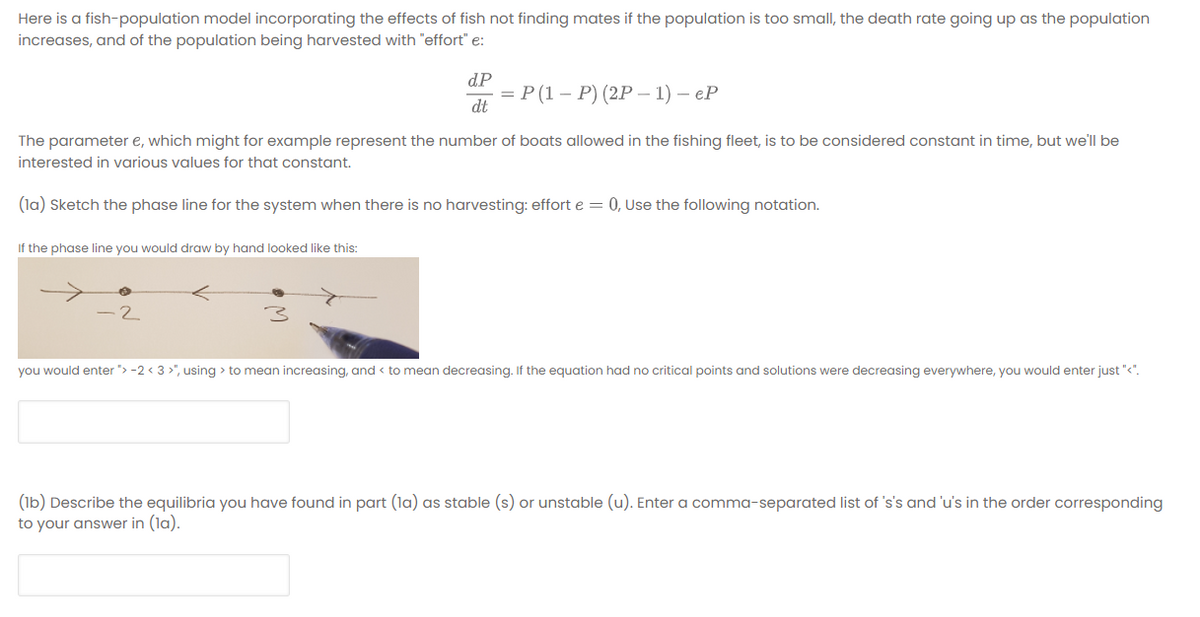Here is a fish-population model incorporating the effects of fish not finding mates if the population is too smalI, the death rate going up as the population increases, and of the population being harvested with "effort" e: dP —D Р(1— Р) (2Р — 1) — еР dt The parameter e, which might for example represent the number of boats allowed in the fishing fleet, is to be considered constant in time, but we'll be interested in various values for that constant. (la) Sketch the phase line for the system when there is no harvesting: effort e = 0, Use the following notation. If the phase line you would draw by hand looked like this: 2 you would enter "> -2 < 3 >", using > to mean increasing, and < to mean decreasing. If the equation had no critical points and solutions were decreasing everywhere, you would enter just "<". (Ib) Describe the equilibria you have found in part (la) as stable (s) or unstable (u). Enter a comma-separated list of 's's and 'u's in the order corresponding to your answer in (la).
Here is a fish-population model incorporating the effects of fish not finding mates if the population is too smalI, the death rate going up as the population increases, and of the population being harvested with "effort" e: dP —D Р(1— Р) (2Р — 1) — еР dt The parameter e, which might for example represent the number of boats allowed in the fishing fleet, is to be considered constant in time, but we'll be interested in various values for that constant. (la) Sketch the phase line for the system when there is no harvesting: effort e = 0, Use the following notation. If the phase line you would draw by hand looked like this: 2 you would enter "> -2 < 3 >", using > to mean increasing, and < to mean decreasing. If the equation had no critical points and solutions were decreasing everywhere, you would enter just "<". (Ib) Describe the equilibria you have found in part (la) as stable (s) or unstable (u). Enter a comma-separated list of 's's and 'u's in the order corresponding to your answer in (la).
Algebra & Trigonometry with Analytic Geometry
13th Edition
ISBN:9781133382119
Author:Swokowski
Publisher:Swokowski
Chapter4: Polynomial And Rational Functions
Section: Chapter Questions
Problem 5T
Related questions
Question

Transcribed Image Text:Here is a fish-population model incorporating the effects of fish not finding mates if the population is too small, the death rate going up as the population
increases, and of the population being harvested with "effort" e:
dP
— Р (1- Р) (2Р — 1) — еР
dt
The parameter e, which might for example represent the number of boats allowed in the fishing fleet, is to be considered constant in time, but we'll be
interested in various values for that constant.
(la) Sketch the phase line for the system when there is no harvesting: effort e = 0, Use the following notation.
If the phase line you would draw by hand looked like this:
-2
you would enter "> -2 < 3 >", using > to mean increasing, and < to mean decreasing. If the equation had no critical points and solutions were decreasing everywhere, you would enter just "<".
(1b) Describe the equilibria you have found in part (la) as stable (s) or unstable (u). Enter a comma-separated list of 's's and 'u's in the order corresponding
to your answer in (la).
Expert Solution
This question has been solved!
Explore an expertly crafted, step-by-step solution for a thorough understanding of key concepts.
This is a popular solution!
Trending now
This is a popular solution!
Step by step
Solved in 3 steps with 3 images

Recommended textbooks for you

Algebra & Trigonometry with Analytic Geometry
Algebra
ISBN:
9781133382119
Author:
Swokowski
Publisher:
Cengage

Algebra & Trigonometry with Analytic Geometry
Algebra
ISBN:
9781133382119
Author:
Swokowski
Publisher:
Cengage